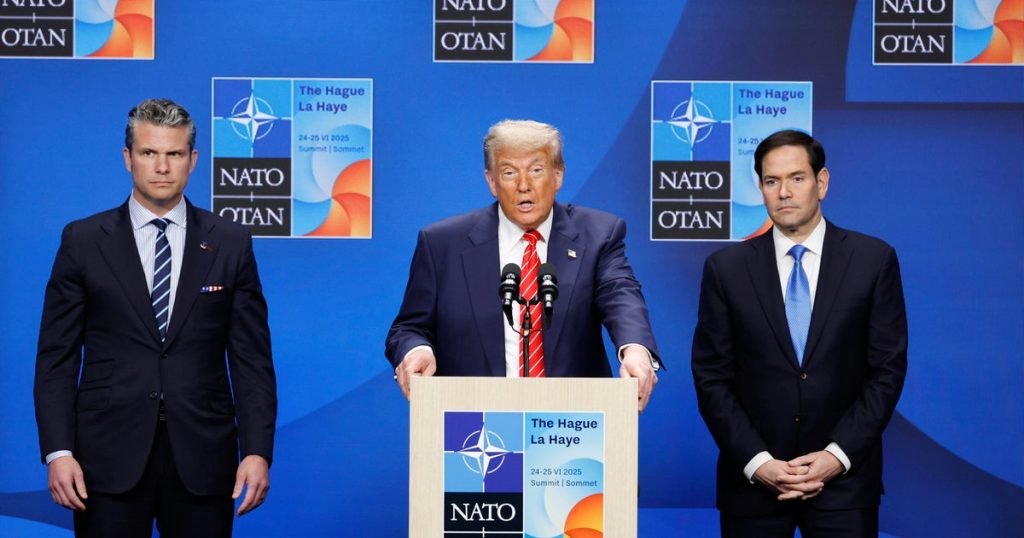President Donald Trump is holding a crucial news conference on Wednesday following the conclusion of a NATO summit in The Hague, Netherlands. The summit occurs during a delicate ceasefire recently brokered by the Trump administration between Israel and Iran, following a 12-day conflict that resulted in significant casualties. The atmosphere appears to be one of cautious optimism as discussions surrounding defense spending and Middle East peace prospects take center stage.
| Article Subheadings |
|---|
| 1) Summit Highlights and Key Discussions |
| 2) The Israel-Iran Ceasefire: Current Status |
| 3) NATO’s Defense Spending Goals |
| 4) Meetings with Global Leaders |
| 5) Future Implications for U.S. Policy |
Summit Highlights and Key Discussions
The NATO summit served as a significant platform for international dialogue amid pressing global issues. During the event, President Trump emphasized the importance of unity among NATO allies. In his remarks, he indicated that the strategies discussed could lead to improved security environments. Officials noted that the second day of discussions focused largely on geopolitical tensions, particularly in the Middle East and Eastern Europe.
Reports suggest a positive mood surrounding the summit, with many leaders expressing newfound determination to address security concerns. Trump specifically highlighted advancements in collective defense measures, while reinforcing America’s commitment to NATO’s mission. Sources attending the summit noted that the atmosphere was poised for constructive dialog, rather than discord.
The Israel-Iran Ceasefire: Current Status
The ceasefire between Israel and Iran represents a critical achievement that stemmed from intense negotiations led by the Trump administration. Through various diplomatic channels, officials worked tirelessly to secure a halt to hostilities after a violence-ridden 12 days that left 28 Israelis dead and hundreds in Iran. The efforts were further supported by negotiations from various international parties invested in regional stability.
In addressing the ceasefire, Trump remarked, “Our actions have effectively set back Iran’s enrichment capabilities by decades.” However, an initial classified assessment from the Defense Intelligence Agency offers a contrasting view, estimating that U.S. airstrikes against Iranian nuclear facilities may have only delayed Iran’s nuclear ambitions by a few months. Observers pointed out the disparity between public statements and internal assessments as a potential area for concern.
NATO’s Defense Spending Goals
One of the primary focuses of the summit was the increase in defense spending among NATO member countries. Despite longstanding insistence on members meeting their defense obligations, Trump confidently noted that NATO countries, with few exceptions, are on a path to increase their defense budgets to 5% of GDP. This comes at a time when the U.S. has not yet reached this target, raising questions about financial responsibilities within the alliance.
Before departing for the summit, Trump asserted that the U.S., having historically contributed significantly to NATO, should be exempt from meeting these spending benchmarks. Nonetheless, NATO Secretary-General Jens Stoltenberg echoed members’ commitment to improving collective defense capabilities, indicating that increasing defense budgets aligns with the alliance’s strategic objectives.
Meetings with Global Leaders
In addition to addressing NATO members, Trump engaged in one-on-one discussions with key global leaders throughout the summit. Among these figures was Volodymyr Zelenskyy, the President of Ukraine, with whom Trump discussed the ongoing conflict in Eastern Ukraine. Zelenskyy expressed appreciation for the U.S. commitment to seeking peace and stability amidst ongoing strife.
During these bilateral meetings, leaders exchanged views on pressing security issues and discussed pathways to peace. In particular, Zelenskyy mentioned their discussion centered on achieving a sustainable ceasefire. The engagement reflects a proactive approach among NATO members to enhance collective responses to regional threats.
Future Implications for U.S. Policy
Looking ahead, the outcome of this NATO summit will likely shape U.S. foreign policy regarding NATO and Middle Eastern relations. As international dynamics continue to evolve, Trump‘s administration appears committed to leveraging strengthened alliances to foster talking points on both military and economic cooperation.
With many leaders united in affirming their commitment to shared defense, the implications for future global stability cannot be overstated. Analysts are watching closely for signals that these discussions will translate into actionable strategies that enhance national security and regional peace efforts.
| No. | Key Points |
|---|---|
| 1 | NATO summit serves as a platform for dialogue among world leaders. |
| 2 | Cautious optimism surrounds the Israel-Iran ceasefire negotiations. |
| 3 | NATO countries are establishing goals to increase defense spending significantly. |
| 4 | Bilateral meetings focused on achieving more stable geopolitical relationships. |
| 5 | The outcomes of the summit could influence future U.S. foreign policy decisions. |
Summary
The NATO summit marked a pivotal moment for nations to address pressing global issues, particularly regarding the Israel-Iran ceasefire and NATO’s collective defense strategies. With Trump at the forefront, discussions surrounding enhanced defense spending and collaborative peace initiatives set a tone of optimism for future international cooperation. As outcomes from this summit unfold, they are expected to significantly impact U.S. foreign policy and international relations.
Frequently Asked Questions
Question: What are the key outcomes of the NATO summit?
The summit highlighted discussions on defense spending increases among NATO countries, an ongoing Israel-Iran ceasefire, and various bilateral meetings between Trump and other global leaders.
Question: Why is the Israel-Iran ceasefire significant?
The ceasefire marks an important milestone in reducing hostilities and casualties in the region and reflects broader diplomatic efforts to promote peace.
Question: How does NATO’s defense spending relate to U.S. policy?
NATO’s focus on increasing defense spending aligns with U.S. interests for greater security cooperation among allies, potentially influencing future U.S. foreign policy directives.


